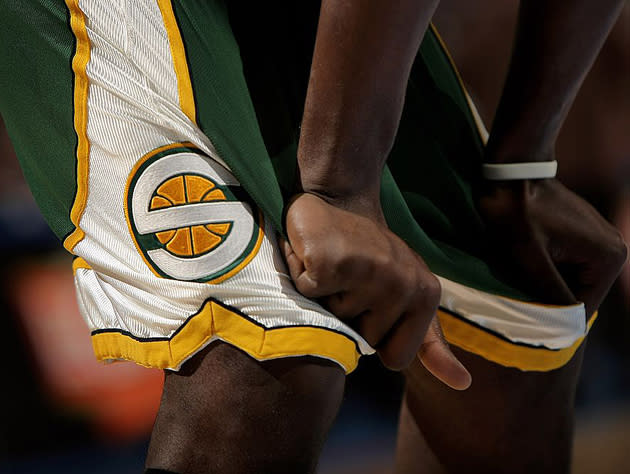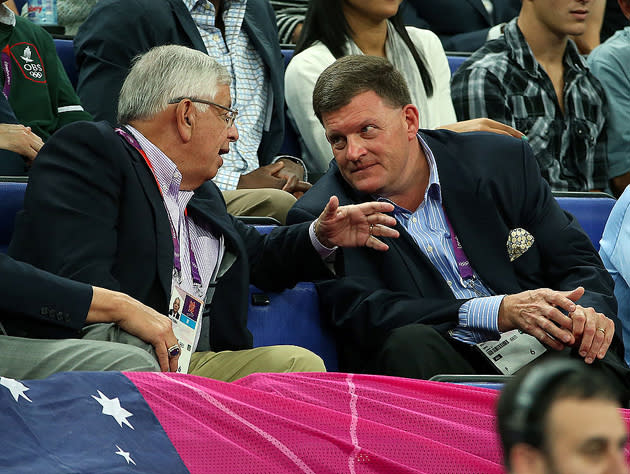Seattle's re-introduction back into the NBA may not be 'looming,' exactly

No, the NBA isn’t any nearer to adding a team in Seattle, Las Vegas, Mexico City, or anywhere else in 2017 than it was in 2016. This despite some rumblings from corners of the web that had the league looking to add to its 30 teams with new franchises in various far-flung corners, and with the city of Seattle apparently giving the cold shoulder to NBA commissioner Adam Silver.
[Sign up for Yahoo Fantasy Basketball | Mock Draft | The Vertical | Latest news]
[Follow Ball Don’t Lie on social media: Twitter | Instagram | Facebook | Tumblr]
Yeah, nobody’s giving Adam Silver the cold shoulder. And Adam Silver, working in a league that is flush with cash and opportunity and ages away from considering expanding a league that is months removed from its most cash-laden free agent turn in history, is taking things nice and slowly as he considers his options.
This isn’t to say the NBA has gone all thin, in the face of expansion. Far from it. The league, which hasn’t expanded since 2004, is sated; and the Seattle Times recently put the kibosh on a rather excitable report from a website called ‘16 Wins a Ring,’ and its contention that NBA expansion was “looming.”
The website “16 Wins A Ring’’ put out a post — co-authored by Adam Joseph and Keith P. Smith — early Monday claiming unnamed NBA sources say the league will soon announce expansion for two teams. It stated the league is considering Seattle, Mexico City and Louisville and that Seattle is “a lock” to get a franchise if it straightens out its arena situation.
The post also claims NBA Commissioner Adam Silver is frustrated that Murray has been “ducking his calls” and that the league has tried to reach the city numerous times with no callbacks. It added: “The league will reportedly be in town this week for serious talks in finalizing details and clarification on the arena situation.’’
An NBA source told The Seattle Times there was absolutely no truth to the post. The source said nobody from the league’s head office planned to meet or talk with any Seattle officials or groups in this city or anyplace else in the near future.
[…]
Joseph said via text message Monday that the site stands by the story.
League sources say Silver has said privately that Seattle is a lock for one of the spots, unless the city itself can’t sort its arena issues. Silver has been frustrated by Seattle Mayor Ed Murray’s ducking of his calls and meeting requests.
A source divulged that Adam Silver and the league have attempted to contact the city of Seattle on multiple occasions with no call backs. The league has wanted to help push their arena efforts forward, but the city has seemingly not appeared fully invested.
You’ll recall that Seattle did host an NBA team from 1969 until 2008, prior to the Seattle SuperSonics’ move to Oklahoma City, following the locals’ decision not to gift the NBA and SuperSonics owners with $220 million in public funding for a new arena.
[Follow Dunks Don’t Lie on Tumblr: The best slams from all of basketball]
[Join a Yahoo Daily Fantasy Basketball contest now | Free NBA Yahoo Cup entry]
The SuperSonics moved on to OKC in poor faith, as exemplified by the under-the-table work of the late Aubrey McClendon and his co-owner cohort in Clay Bennett, but as we detailed before the seeds of the move were planted when former Starbucks CEO Howard Schultz lost his nerve after a few failed swipes as an NBA owner, selling the team away from the city that made him rich and famous, dealing to Bennett and McClendon – two Oklahoma businessmen who obviously had clear designs on a Seattle-to-Oklahoma City move from the outset.
A move that the NBA, pathetically pandering to huge swaths of fans toward the late stages of former commissioner David Stern’s career, happily signed off on. After Howard Schultz attempted to and eventually failed to save face, of course.
Luckily for the league, which fancies itself on the right side of history in matters both private and public, they’ve yet to be faced with a significant staredown in the years since with an NBA city over the concern of public funding for arenas. Cities are still signing off on making life a little easier for the billionaires to have their toy and break it, too.
The loggerheads will present themselves at some point, but not before every side gets its story straight. The NBA likes the idea of toying with new locales in order to drive interest, but the league remains happy with its even number of teams. Seattle, despite some inroads made during a failed attempt to act the heel in taking the Sacramento Kings away from their hometown, is still a spell and a half away from settling its attempts to have an NBA-ready arena launched into the discussion.
Though the 16 Wins a Ring report can be summarily dismissed, there is a reason the idea of expansion has been brought up. It goes beyond the league’s recent trip to Mexico City, or the upcoming ten-year anniversary of the time that Kevin Durant was drafted by an NBA team in Seattle.
(To say little of Seattle’s decision to draft Russell Westbrook in 2008.)
The NBA dipped its toe into the expansion waters a few times in the 1950s and 1960s without great success, watching as clubs in cities as large as Chicago still failed to register amongst the punters. The league’s slow growth made it so the addition of four ABA squads in 1976 – squads the NBA classified as “expansion” teams despite their great ABA success and preponderance of All-Star talents – was seen as a somewhat risky move for a struggling collection of NBA franchises.
That changed in the 1980s, and the addition of an expansion squad in an emerging, yuppie city like Dallas was the correct response from the NBA. As was adding clubs in Charlotte, Miami and Orlando nearly a decade later. With the Charlotte club’s move to New Orleans in 2002, coupled with the re-emergence of another Charlotte club a year and a half later, the league seemed set at 30 teams.
A few years of economic uneasiness – for both the league and the country it (mostly) played in – followed the addition of the NBA’s 30th team in Charlotte. That uncertainty, along with no easy route to a free arena, was part of the reason the league declined to set up shop with another Seattle team as soon as the SuperSonics split in 2008. Seattle’s pointed decision not to splurge for yet another professional sports complex, something that hadn’t bothered the city in the past and hardly triggered Charlotte in the years prior to the introduction of the Charlotte Bobcats, made the NBA’s decision all the more easier.
Both sides had good reasons not to create a new NBA team, even if neither side truly got what it wanted.

Entering 2017, though, with the league booming and heaps of international and domestic players making even lottery-fated outposts like Brooklyn and Phoenix still worth watching despite all their losses, the time seems set for a re-introduction. Better for the league’s team owners is the idea that an expansion fee would run into the billions of dollars. The stage is set, with even a year-old list of Forbes valuations placing the 13th-ranked Phoenix Suns (last in the West, seven straight seasons in the lottery) at worth over a billion bucks.
Still, the expansion fee would only provide each team with revenue approximating about a third of this season’s salary cap, something falling just short of a windfall.
Then again, these are NBA team owners. They’ll bid against themselves for players hardly worth the money they sign for in free agency during the summer, prior to crying poverty in the winter. They’ll spend tens if not hundreds of millions in the offseason and commit to a series of regular season moves with significant financial burden just to make it to the first round of that year’s playoffs, where the reward is a gate receipt deposit worth around what Milwaukee Bucks rookie Thon Maker (16 games, 74 total minutes) is making this year.
These are owners that won’t hesitate for a second in throwing good money after bad when it comes to trades, draft picks and especially signings, but they’ll quibble and gnash teeth at the thought of paying a fired coach not to work for the team, even if it meant retaining the coach (sometimes at a fraction of what Thon Maker makes) at the expense of your team’s ability to make the playoffs.
What we’re saying is, NBA owners are selective in very odd ways. For the overwhelming majority of them, NBA teams serve as a vanity project while they make their billions elsewhere. Yet they’ll get awfully precise when it comes to securing an extra $3 or $30 million, even while twice as much escapes out of a hole in the screen door that they refuse to pay to repair.
The loss of an NBA team in Seattle is one of the great crimes in the league’s history, though we completely agree with our own Eric Freeman when he points to the termination of the Vancouver Grizzlies as something altogether more severe, as Grizzlies fans were denied a chance to fall in love with what should have been a Northwest staple due to team and league mismanagement.
Seattle fell in love with its SuperSonics, a three-time NBA Finalist and 1979 league champion, and for good reason. The focus on their return, as spearheaded by mayor Ed Murray, still isn’t moving forward with what you’d call “alacrity,” however. From the Seattle Times:
The city has issued an April 12 deadline for proposals to renovate KeyArena. Both AEG and the Oak View Group, each based in Los Angeles, have said they will submit proposals and spokesmen for both companies confirmed Monday they had no talks were scheduled with Silver this week.
Murray has also said the city will consider a revised proposal by entrepreneur Chris Hansen in Sodo District, but only after it’s decided whether or not KeyArena is a viable option. Sources have said a KeyArena remodel could take three-to-five years to complete once a proposal is approved.
That’s the same KeyArena you remember from the first round of the 1993 Western Conference playoffs. The arena that predates the Beatles’ (and even George Harrison’s) first visit to America. It’s not as simple as suggesting that they’re still dealing with a workaround on the old plan, but we still have a long way to go.
That doesn’t mean Seattle, the NBA, Sonics Rising (the former Save Our Sonics) and all manner of objective sporting types don’t want to see a team back in Washington.
Nothing appears to be “looming” just yet, though.
– – – – – – –
Kelly Dwyer is an editor for Ball Don’t Lie on Yahoo Sports. Have a tip? Email him at KDonhoops@yahoo.com or follow him on Twitter!


